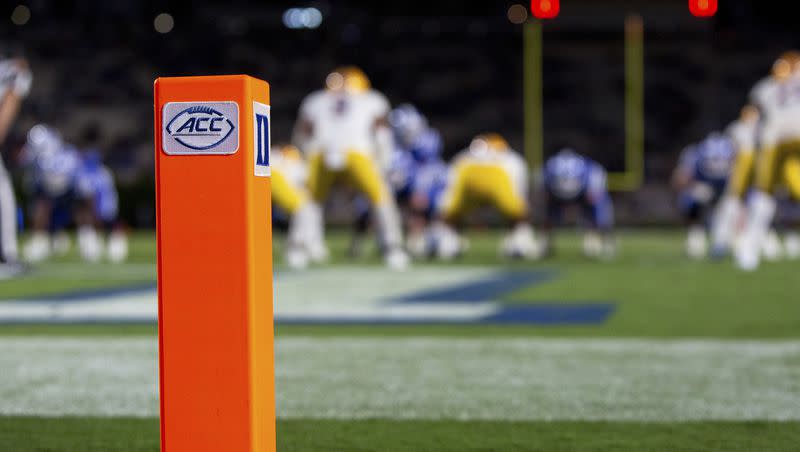Analysis: What ACC expansion means for college football and athletics at Stanford and Cal

After several weeks of talks and speculation, the possibility of the Atlantic Coast Conference expanding and grabbing two of the final four Pac-12 teams is a reality.
Multiple news outlets reported Friday morning that ACC presidents and chancellors voted to extend invitations to Stanford, California and SMU. Within a couple hours, the ACC made the move official, announcing the three schools as new members.
The three schools are expected to join the league beginning with the 2024-25 season.
“We are thrilled to welcome three world-class institutions to the ACC, and we look forward to having them compete as part of our amazing league,” ACC commissioner Jim Phillips said in a league statement. “Throughout the evaluation process, the ACC Board of Directors, led by President Ryan, was deliberate in prioritizing the best possible athletic and academic experience for our student-athletes and in ensuring that the three universities would strengthen the league in all possible ways.
“Cal, SMU and Stanford will be terrific members of the ACC and we are proud to welcome their student-athletes, coaches, staff and entire campus community, alumni and fans.”
When league presidents met Aug. 9, a straw poll came up one vote short of approval, with Clemson, Florida State, North Carolina and North Carolina State against expansion, according to Yahoo Sports’ Ross Dellenger.
With the league needing 12 of its 15 presidents and chancellors to vote in approval of expansion before such a move could take place, one of those schools would have needed to switch their vote. The vote that flipped came from NC State, according to ESPN.
The move means there will be 17 football members in the ACC beginning next season and 18 total members (Notre Dame competes in the league in all sports but football and men’s hockey).

What does it mean for Stanford, California and SMU?
For Stanford and Cal, two of the most prestigious academic institutions in the United States, the move keeps the two West Coast schools at the power level.
Both schools are going through struggling times with their football programs, but both also have a robust amount of Olympic sports programs. Stanford, in particular, is annually one of the top athletic departments nationally.
Notre Dame athletic director Jack Swarbrick, whose school is a voting member in the ACC even while the Fighting Irish’s football program competes independently, has been an advocate for Stanford and California joining the league, according to ESPN’s Heather Dinich.
On Aug. 10, Dinich said on the social media platform X, “ND AD Jack Swarbrick told me the reason they advocated for Cal and Stanford was because “The notion that two of the very best academic institutions in the world who also play DI sports could be abandoned in this latest chapter of realignment is an indictment of college athletics.”
The ACC sponsors 15 women’s sports — the most among all Autonomy Five conferences, according to the league — and also sponsors 28 sports.
Stanford sponsors 36 varsity sports, including 20 women’s sports. The school said it expects that 22 of those 36 sports will “see either no scheduling changes or minimal scheduling impacts” as the ACC and Stanford work together to optimize scheduling.
“ACC membership aligns Stanford with a conference of leading peer institutions who share a deep history of athletic success and a commitment to the pursuit of academic excellence. We appreciate the invitation of the ACC member schools, and we are excited to join them,” Stanford board of trustees chair Jerry Yang said in a school statement.
California, meanwhile, acknowledged that “while membership in the ACC will result in some increased travel for student-athletes and staff,” the school projected that 19 of its 30 sports will experience little change regarding travel. “UC Berkeley will also explore measures to minimize the effect additional travel could have on the remaining student-athletes,” the school said in a press release announcing the move.
“We are very pleased with the outcome, which will support the best interests of our student-athletes and aligns with Berkeley’s values,” California chancellor Carol T. Christ said in a statement. “We are confident that the ACC and its constituent institutions are an excellent match for our university and will provide an elite competitive context for our student-athletes in this changing landscape of intercollegiate athletics.”

For SMU, the choice is even simpler: the move gets them to the power conference level.
The Mustangs were members of the Southwest Conference from 1918-96 alongside blue-blood programs like Texas and Texas A&M, among others. But when the Southwest Conference dissolved and the Big 12 came into formation in 1996, SMU was left out.
Since then, the Mustangs have been part of the Western Athletic Conference (1996-2005), Conference USA (2005-13) and the American Athletic Conference (2013-present).
“This is a transformational day for SMU,” school president R. Gerald Turner said in a statement. “Becoming a member of the ACC will positively impact all aspects of the collegiate experience on the Hilltop and will raise SMU’s profile on a national level. We want to thank everyone who has helped position SMU for this important moment. Joining the ACC is an historic milestone in our institution’s history, and the start of a new chapter in SMU Athletics.”
One idea that’s being discussed by the ACC to reduce travel costs and ease country-country travel includes playing some league contests in Dallas.
“The ACC is really interested in using Dallas as a place where teams might come together to have games to minimize the impact of travel on both eastern members and Cal and Stanford,” Christ said, per The Mercury News’ Jon Wilner.
What does it mean for the ACC?
The ACC has been dealing with its own dissent in the ranks, thanks to a 20-year media rights deal that extends through 2036 that comes with hefty exit fees.
Florida State, in particular, has voiced its displeasure about revenue sharing, while Big Ten and Southeastern Conference teams are drawing an ever-increasing amount more in media rights revenue shares than schools from other power conferences ACC and the Big 12.
What changed in recent weeks, then, for the ACC to consider expansion west? It came down to financial details and creating incentives for ACC schools to vote yes on bringing in new members.
It will take 10 years for Stanford, California and SMU to receive a full share of the ACC’s media rights revenue payouts, according to ESPN and Yahoo Sports.
SMU will not receive any broadcast media revenue for nine years, instead relying on booster contributions to compete financially, while Stanford and Cal will receive 30% of the ACC share for the next seven years, followed by a jump to 70% in Year 8 and 75% in Year 9, ESPN’s Pete Thamel reported.
That money being held from the three schools — around $55 million, according to Yahoo Sports’ Ross Dellenger — will then be distributed to ACC teams. Part of it will be divided proportionally amongst the league’s current 14 full-time members and Notre Dame, while another portion will be given to schools based on an incentive system primarily rewarding football success, per Dellenger.
“The incentive pool from the additional expansion revenue is heavily weighted on football success,” Dellenger wrote. “In one proposal circulated among officials, the cash would be distributed based only on football success. It’s unclear if that proposal has been formalized. A school that reaches all football incentives (national title) stands to get as much as $10 million in additional cash.”
Per Dellenger, the additional money comes from ESPN through the network’s media rights deal with the ACC. The contract between ESPN and the conference contractually obligates the network to pay the ACC a Tier 1 TV share of roughly $24 million for each additional expansion school, according to Dellenger, which totals $72 million.

What does it mean for the Pac-12?
At this point, 10 of the Pac-12’s 12 teams will be in a new conference next year.
USC, UCLA, Oregon and Washington are headed to the Big Ten Conference.
Utah, Arizona, Arizona State and Colorado are leaving for the Big 12.
That leaves just two schools, Oregon State and Washington State, without a home for next season.
Last week, The Athletic’s Chris Vannini reported that officials from the Mountain West Conference and the American Athletic Conference are courting both schools, while waiting to see how the ACC development would work itself out.
AAC commissioner Mike Aresco released a statement Friday morning, essentially shutting the door on further expansion for the American at this time.
“We have known that today’s move was a possibility, which has allowed us time to investigate a number of options, including consideration of the larger group of institutions in the Pacific time zone. We have concluded, however, that the best way to proceed for our outstanding student-athletes is to not look westward,” Aresco said.
“Instead, we plan to focus any expansion efforts on schools that allow for sensible and sustainable competition and student-athlete well-being within our strong geographic footprint. We look forward to continued success as a leading FBS conference.”
With clarity on the ACC, Cal and Stanford, it’s likely there will be more swift movement to have a resolution for Oregon State and Washington State and whether the Pac-12 can survive in some form.
One potential option that has been speculated could be a merger with the MWC, with the details to be sorted out later.
At least geographically — which has meant little thus far in the realignment chaos — Oregon State and Washington State would be good fits with the MWC schools, though joining with them would expect to lose the universities valuable power conference status.
What does it mean for college athletics?
Beginning next year, four of college sports’ power conferences will all have 16 or more members.
Their numbers will be as follows:
Big 12: 16 members.
Big Ten: 18 members.
SEC: 16 members.
ACC: 18 members (Notre Dame is a member of the league in all sports, except football and men’s hockey).
What that all means for college football, and specifically regarding access to the College Football Playoff, has yet to be sorted out, though it’s expected that criteria will change with the Pac-12 losing nearly all of its members at this point.
The playoff is expanding to 12 teams in 2024, and the current model is that the top six ranked conference champions will earn an automatic spot in the playoff, with six additional spots going to at-large berths.
On Wednesday, CFP officials met and no changes to the selection format were announced.
One possibility, Dellenger reported, is that the format could change to a 5+7 model, with five automatic berths and seven at-large spots.

